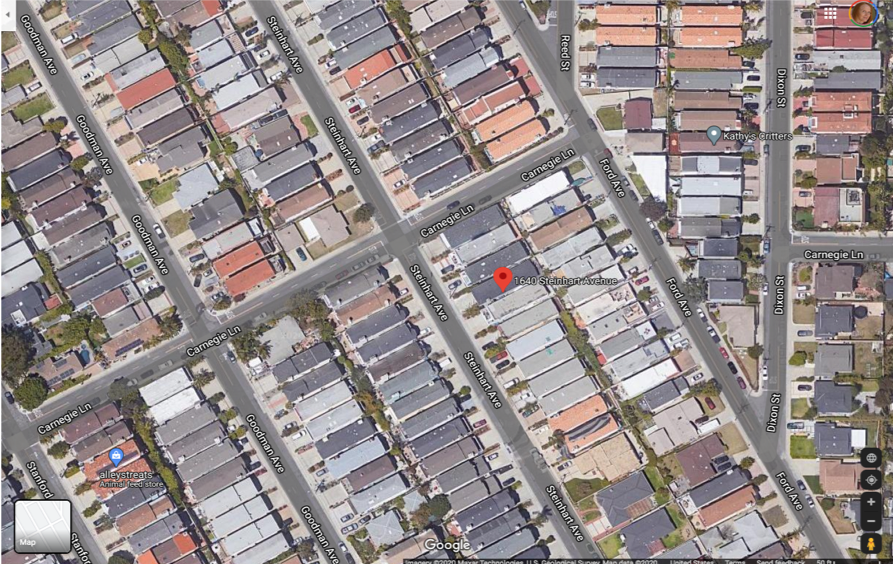Most journalists believed that SB 1120, California’s banner housing bill for 2020, was a modest “duplex” bill. SB 1120 failed because enough people realized it was a radical experiment to transform single-family homes into 8-unit market-rate rentals. (Google Earth photo above: SB 1120 would make single-family streets far more dense than these streets in the “Tall and Skinnies” in Redondo Beach: Several units per lot built close to the lot lines.)
SB 1120’s authors intended to disrupt the way 21M Californians live by ending single-family zoning, but could only achieve this if the public was in the dark. Legislators held rushed hearings under cover of COVID-19.
SB 1120 died at midnight on Aug. 31, when some hesitant legislators appeared to drag out debate, blowing past a legal deadline and killing the bill. It was that close. But the forces behind this bad bill are not going away, and we expect yet another plan to crush single-family areas in the next couple of months. The copycat bill for 2021 is called SB 9 and it repeats the language of SB 1120 word for word, with an added swipe at public hearings in coastal zones.
Written by developers who would profit, SB 1120 was pushed hard by Bay Area state Sen. Scott Wiener and his followers, who insist that awarding power and perks to developers of dense market-rate housing helps the poor.
Livable California is stunned by this disproved, divisive and wrong-footed theory.
SB 1120 allowed destruction of thousands of homes and yards to erect dense market-rate housing separated by a four-foot space, and let speculators bid against families on homes — to demolish them and build up to 8 units of market-rate rentals.
No state gives developers such power. Only Oregon plans to end single-family zoning, to allow duplexes only, phased in during 2021 and 2022. Those who claim “it’s working in Oregon” are wrong. The Oregon law has not kicked in. SB 1120 hearings were rushed and minimal. Our state senate voted to turn vast areas into market-rate rentals without yards or fire-defensible space.
Several top-notch attorneys, without pay, helped us unwind the SB 1120 language:
- SB 1120, at a minimum, allowed 4 McMansions, or 4 full-sized houses, where 1 house sits now — no yard, no garage.
- SB 1120 also allowed 4 full-sized houses plus 2 granny flats (ADUs), for a total of 6 houses and granny flats where 1 house sits now.
- SB 1120 also allowed 4 full-sized houses with 2 granny flats and 2 “junior” ADUs (small flats attached to the main houses), for a total of 8 houses and granny flats where 1 house sits now.
- All built without public hearings, and impacting some 20,000 neighborhoods.
- Communities had one recourse: SB 1120 allowed residents to try to persuade their City Council to allow “only” 4 units on a lot where 1 home now sits.
Misdirection by SB 1120’s authors led to broad misreporting by major news outlets who accepted the spin:
- Los Angeles Times 8/26, “Would allow a duplex on most single-family parcels”
- San Francisco Chronicle 5/21, “Easier to split lots and convert homes into duplexes”
- San Diego Union-Tribune 9/1, “Allowed duplexes on most single-family lots”
- Cal Matters 9/2, “Allow duplexes where previously only one home could be built”
- The Real Deal 8/26, “SB 1120 Would Allow Duplexes in Suburbia”
Here are some ways the authors misled journalists and many state legislators who voted for SB 1120:
- The bill’s language doesn’t contain the word “duplex.” That false claim came from the authors and from senate and assembly “bill analyses” widely read in Sacramento. Such analyses are not legally binding but are often trusted. But on SB 1120, the analyses dissembled.
- Only PhDs could follow this part of SB 1120: “(e) Notwithstanding Section 65852.2, a local agency shall not be required to permit an accessory dwelling unit on parcels that use both the authority contained within this section and the authority contained in Section 66411.7.” This meant that if your City Council didn’t ban granny flats, a developer could build 8 units per lot – 4 houses and a mix of 4 large and small granny flats — where 1 house sits now.
- A Dog Whistle to developers required that anyone who chose to split a lot to build 2 units on each new side had to slice it into 2 exactly matching sizes. “(1) The parcel map or tentative and final map subdivides an existing parcel to create two new parcels of equal size.” Why? Because few homeowners can chop their property in half without demolishing their own home. How many developers can demolish a home in a blink, then erect 8 lucrative market-rate dwellings on the lot? The answer is that many can.
- We found several other sections in SB 1120 written to benefit developers and speculators, not homeowners.
No state in the U.S. is even considering the radical rezoning of single family homes to 4-to-8 units.
Under pressure from Senate President Pro Tem Toni Atkins to approve and send SB 1120 to the Assembly, the 40-member California State Senate voted for this experiment by “consent” — a vote taken on purportedly non-controversial bills with full support of the senate.
Only state Sen. Henry Stern of the West San Fernando Valley, perhaps savvy to SB 1120’s bleak outcome, chose not to vote. This means your own state senator voted for SB 1120.

